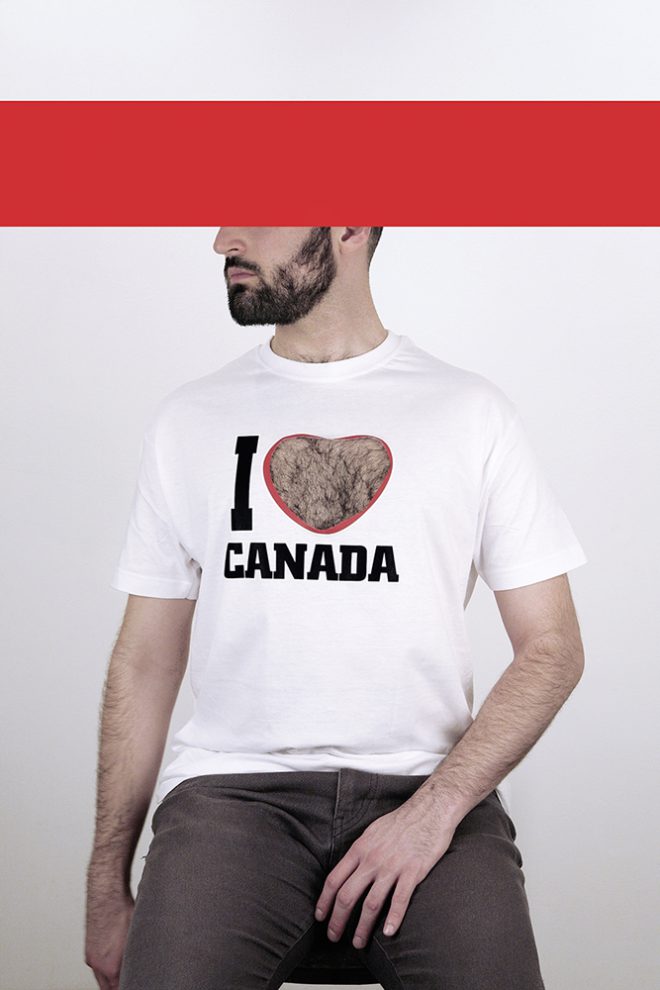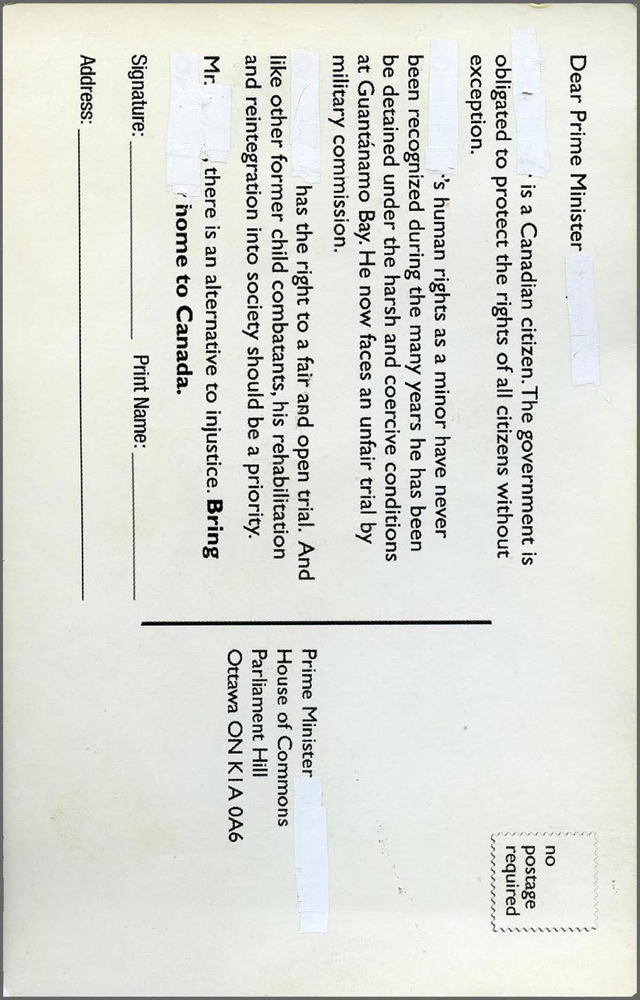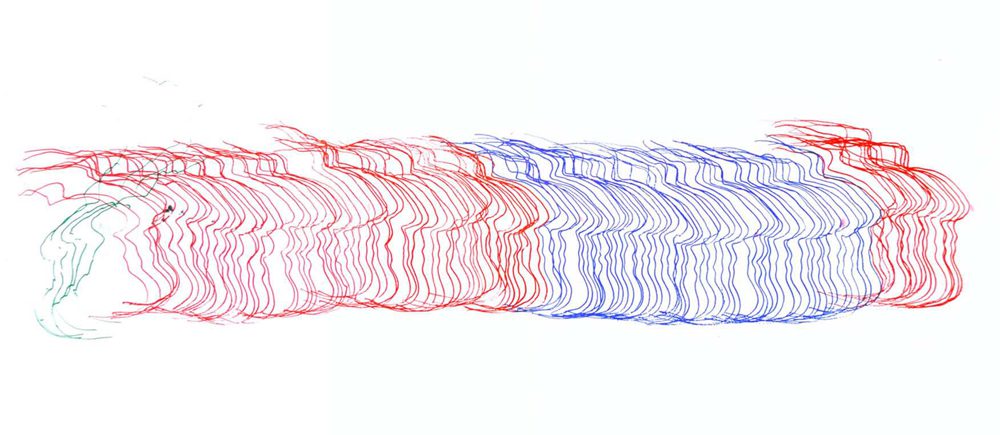Abstracting the Self: An Interview with Francisco-Fernando Granados
Curator Christian Camacho-Light discusses the politics of abstraction with Francisco-Fernando Granados, whose work was included in Camacho-Light’s recent thesis exhibition at the Center for Curatorial Studies at Bard College.

Francisco-Fernando Granados, portrait (I <3 CANADA), 2012-14. Chromogenic print. Courtesy the artist. Photo by Manolo Lugo.
Christian Camacho-Light: I’ve been thinking about your work portrait (I <3 Canada), 2012-14, which is a photographic self-portrait, and the ways in which nation-states demand of their subjects certain representable forms so that they may be identified and legitimized as such. Assimilation into a nation-state, for instance, seems deeply related to both visuality and legibility. Can you speak a little bit about the origin of the work?
Francisco-Fernando Granados: portrait (I <3 Canada) came about as a conceptual response to a project I did called apostrophe, 2012. An apostrophe is not only a mark of belonging and possession or a mark of omission. As a rhetorical device in theater, apostrophe is the moment in which a character turns away from the audience and addresses either an absent character or a personified abstraction. My project was a performance-installation that staged an impossible correspondence between me and Omar Khadr, an Egyptian-Canadian man around my age who was arrested in Afghanistan as a child soldier and detained in Guantanamo.
I had this postcard I had picked up a number of years ago. On it was a portrait of Khadr as a 14-year-old boy, and something about that image compelled me. That portrait became the starting point for apostrophe. I noticed that there were all these non-parallels between our lives: Khadr is from Toronto and I had just moved to Toronto; I had become a Guatemalan-Canadian and he was an Egyptian-Canadian; his father sent him to Afghanistan around the same time that I came to Canada; he was arrested while I was in high school; when I started my master’s program, his trial had just begun. So as I was coming into subjective civic recognition—from having been a refugee claimant, a Convention refugee, a permanent resident, and then a citizen—there was someone else who, at the same time, had left that frame of citizenship, had left the frame, at least juridically, of recognizable humanity.
There were reports—really cruel, mocking reports—in the conservative press saying that Khadr had been given a copy of Romeo and Juliet by Shakespeare to read as part of his schooling in Guantanamo, making fun of the idea that he would be reading the part of Romeo with his lawyer playing Juliet. So in the performance, I sat under a spotlight with a copy of the play and blanked out every mention of Romeo’s name and everywhere that Romeo speaks, as a way to mark both the state’s possession of Khadr and the absence of his body within the public sphere. But also to create a space in which he could speak, to produce an absence into which he could step one day.
CCL: Yes, I wanted to ask about the role that representation plays in the performance. There’s no name, no face; Romeo’s lines are blank. And yet, this erasure is also, as you say, an act of mark-making.
FFG: From very early on, I knew, ethically, I could make no claim to his image. I think this was in part because his image was already being circulated so much in the media. And because he was still imprisoned at the time of the performance, I realized that I could not claim his name either. So for as long as he was in prison, I didn’t use his name in relation to the project. At this point, he has been repatriated into Canada. Several years after his release from Guantanamo and reentry into the Canadian legal system, he was placed on parole.
With apostrophe, I was making a work about Khadr without using his likeness, creating a portrait that wasn’t a portrait in the traditional sense. I thought of my approach as tracing the outermost contour of his figure and, as carefully as I could, tracing the shape of his absence. Ultimately, I figured that if I was going to do that, if I was going to address his absence, I had to also find a way to figure myself. I couldn’t be a disembodied voice, and I had to make my position clear. That’s how portrait (I <3 Canada) came about. I took a white tourist t-shirt that said “I <3 Canada” and cut out the heart shape, displaying my chest. Even though it is a self-portrait, I wasn’t depicting myself as an identifiable entity, but rather as a body like mine: racially ambiguous, conventionally masculine. I was interested in refusing identification through the line obscuring my eyes in the photograph. I was trying to find different strategies for making something visible while holding something back.

Francisco-Fernando Granados, apostrophe, 2012-13. Rectified readymade, correction fluid on postcard. Courtesy the artist.
CCL: Something that comes out for me here is this peculiar relationship between collectivity and singularity within the nation-state: A state requires individualized identities in order to control and manage bodies, even as it simultaneously demands of certain groups an undifferentiated homogeneity. I mean the latter in the sense that (and Carrie Dawson has written of this in reference to your work) when one seeks entrance into a nation-state, for asylum or citizenship, they must make certain claims and fit within a prescribed narrative. So they must be exceptional in their need to traverse borders and boundaries, but they must also perform this exceptionality in a very delimited way.
FFG: Absolutely—bodies need to be able to fit in a box in order to form collectivities. This is how the figure of the migrant, the figure of the refugee is shaped. A double bind is imposed—the contradictory instruction of individuality that makes you recognizable and the simultaneous demand for pride in collective identity. In the United States, the metaphor for this is the melting pot. Here in Canada, it’s the mosaic. Both metaphors attempt to capture the way in which bodies are caught in the double bind—made specific enough to be picked out, either for praise or for punishment, and at the same time, made collectifiable enough to form voting blocs and niche markets.
CCL: This makes me think of the book Escape Routes: Control and Subversion in the 21st Century, wherein Dimitri Papadopoulos, Niamh Stephenson, and Vassilis Tsianos discuss what they call the “double-R axiom.” This is a promise that contends that, through belonging to a particular nation-state, you receive protection in the form of rights and representation. And yet, rights and representation are the means by which visibilities are controlled, and visibilities themselves become the means of control.
FFG: It is precisely at the point of becoming visible to the state as governable that the need to abstract oneself becomes politically urgent. For an artist like me, who owes a lot to the politicized aesthetic practices of the ’70s, ’80s, and ’90s, when artists like Adrian Piper, Coco Fusco, and Lorraine O’Grady fought so hard to gain visibility for women, queers, and people of color, I think there is another double bind. This is in understanding myself in relationship to these practices but realizing that the way to honor them is not to follow them in a straightforward manner. I respond to the current context by taking the ways in which we are already overidentified, from state surveillance to social media, and finding degrees to which to abstract them.
CCL: Something I’ve been thinking about lately is how identity politics, as a deployable political force, is sometimes viewed today as fatigued or exhausted of use. A symptom of this appears to be a turn away from an identity politics based on visibility and toward new forms of coalition-building and belonging. I think recent attempts within visual art to mask or abstract the self—to refuse to identify or be made visible—might be one such manifestation of this.
FFG: It works in a very situation-specific way. I think that’s why it’s important to think about degrees of abstraction, rather than abstraction as a totalizing strategy. Certainly here in Canada, because ideas of multiculturalism are so thoughtlessly uneven, Indigenous populations are still in a situation where there is a need for visibility to hold public institutions accountable. Just one example is the need for health and housing services that are not being delivered to Indigenous communities. These services are the responsibility of the federal government. This can also be seen in recent attempts by municipal and provincial governments to use generalized, fuzzy multicultural tropes to get away from being accountable for black Canadian populations who are suffering from police brutality. In political cases like these, there is an urgency for an articulation of identity practices and visibility as a way to ask for accountability.
But in the case of bodies like mine, ethnically ambiguous in ways that can be quite privileged, various degrees of abstraction are valuable. Otherwise, upwardly mobile, migrant bodies become too easily appropriated by power structures. In terms of aesthetics, visibility and abstraction are a spectrum. And as someone interested in the visual, what is both exciting and terrifying is that there can be no preconceived expectation of what a situation might ask for, of what degree of identification or disidentification might be necessary.

Francisco-Fernando Granados’ spatial profiling…, 2013, at Mayworks Festival of Working People and the Arts, Toronto. Courtesy the artist. Photo by Manolo Lugo
CCL: I think that formal abstraction, in your work, for example, then becomes a response to abstractions of a different register, such as citizenship or the visual profiling of bodies by the state. Your performance and site-specific drawing spatial profiling…, 2011-16, for instance, formally abstracts the profile of the face in order to resist these violent scopic abstractions.
FFG: It has taken me a while to understand spatial profiling…. I started the work in 2009 or 2010 as a formal exercise and it took me a couple of years and a conversation with curator and writer Amy Zion to realize that it had to do with abstracting racialization. In the performance, I repeatedly trace the outline of my face in ink on the wall of the gallery over a period of time, until the individual profiles become abstracted into a larger pattern. My own face then becomes unidentifiable to those not present during the performance. I also realized so many important things about the work in the conversations you and I had leading up to “Standard Forms,” particularly around the importance of anonymity, and that it was indeed about a body like mine, and not about my individual identity. And that it should, as it continues, become a conceptual framework that allows for a multitude of bodies to access it, to enter and to exit it.
CCL: Do you see this as a shift toward the democratic?
FFG: Literary critic Gayatri Spivak said in a lecture she gave last year that democracy requires an abstract subject. For her, that means “a position without an identity.” In a way, the language of abstraction, as you point out, is always embedded in the discourses that map identification. Just like there is no borderlessness without borders, there is no abstraction without identification. The state needs the particularities of identification that allow for a scanner to read your iris in biometric surveillance, for example, in order to create these broad, abstract groups of people—stereotyped people like terrorists or enemies of the state .
And as much as these dehumanizing forms of abstraction are part and parcel of how our world works, I agree with Spivak that there is an argument to be made that any hope for a solution lies in the room that abstraction makes for democracy to be about something other than discrete identities. Then it is possible, perhaps paradoxically, to understand that there is nothing inherently abject about people from a particular part of the world, that there is nothing particularly subaltern about certain populations. And this allows us to imagine a future where things might be otherwise.
CCL: This makes me think of the pattern formed by the repeated tracing of your profile—a single face becoming many—and how abstraction might be precisely that which exceeds the individual, though it also, as you mention, remains tethered to it. And this leads us back into the conversation about collectivities. Can you speak more about this, as well as the context of “Standard Forms,” wherein spatial profiling…, completed during the exhibition’s installation, was no longer a performance, but only a drawing?
FFG: Another one of the understandings that I arrived at, leading up to “Standard Forms,” was the importance of highlighting the trace of the action as a work in itself. Indeed, what emerges when the weight of the work is shifted from the action to the mural is the emergence of multiplicity. When the body is there, it is easy to understand what the action is. But the moment that the body is taken away from the viewer and what’s left is only the drawing on the wall, there’s an ambiguity that takes shape. In a way, it becomes a tracing of time, and the passage of time holds within it that contradiction of sameness and difference, where the body is still the same body, but it has changed.
CCL: It is interesting to me to think that each profile in the drawing is simultaneously the same, in that each traces the same face, and different, in that each is a distinct mark made upon the wall. I think there’s a relationship here to how the racially profiled body becomes visual evidence of a specific identity or stereotype singled out for discrimination and violence—so a specificity but also a flattening. But in spatial profiling…, difference emerges through sameness.
FFG: I think this is exactly the possibility for queer resistance within the work—difference that at once is sameness and cannot be possessed. It’s always slipping. No claim can be made to each individual line, as it has to be taken as a whole. And yet, each line is irreducible.
Editor's Note
“Standard Forms” was on view April 3 – 24, 2016, at the Hessel Museum of Art, Center for Curatorial Studies, Bard College, in Annandale-on-Hudson, New York.



